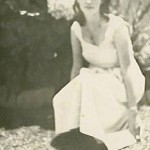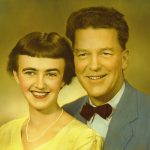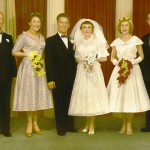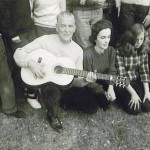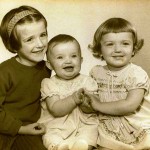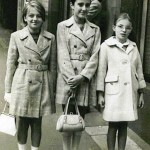Personal Life
On 15th September, 1956 Ray married Moira Winifred Young at St Matthews Anglican Church in Manly. Moira had been a student of Ray’s at the Conservatorium where she had completed her schooling before studying the violin. She fell hopelessly in love with her colourful professor Hanson and while Ray was 42 when they married and Moira only 23, he was not a very experienced man in matters of love. He fell just as deeply for her.Ray told a story of his first date with Moira, how he finally plucked up the courage to ask her out and they had arranged to meet at the large circular statue of Roman Gods outside the Con and to stand near Neptune. Moira arrived on time, but Ray began to have second thoughts, possibly due to the difference in their ages and the way it would perhaps be seen by others. He eventually decided to stroll past the statue some three hours late feeling sure his moment of madness had passed only to find Moira patiently waiting for him imagining she must have got the times mixed up. Her patience was rewarded.
Marriage
Unfortunately Ray’s mother Lillian died some years before the wedding which is perhaps a good thing as it's doubtful she would have approved of the marriage herself, and his father was still a missing figure in his life. Moira’s large family, The Young’s, were not supportive. He was a musician and not a doctor or lawyer. They were married anyhow and moved into Moira’s family home at 7 Bower street Manly to begin their married life together. Moira’s mother Ivy became the only family member who really supported them. Moira’s father died in 1962, and the couple remained very close with Ivy up until her death in 1969.Ray’s family of siblings eventually settled in Queensland but kept in touch via mail. Moira sacrificed her entire family and her career as a violinist to follow her love and was happy to do so at the time. She believed in Ray's brilliance and demonstrated this by shelving her own musical ambitions to support his and become a mother and wife.
Ray and Moira bore three children. Marcelle Josephine in 1958, Annabel Moira in 1960 and Sally Anne in 1961. Marcelle had one son Amon Woulfe in 1979, while Sally had one son Joshua Scrivener in 1983. Annabel two daughters, Julia Anne 1990 and Georgia Josephine 1996. Sadly neither Ray, nor Moira lived to meet their four grandchildren.
(please click on gallery images for larger pictures and descriptions)
Family life
In 1963 Ray and Moira were living in a rental house in Cammeray with three children all under five years of age. They found it increasingly difficult to manage financially because Ray was only paid for the work he performed during the semester. He had no holiday pay, superannuation or sick leave. Consequently, every holiday the family would have to establish a 'tab' at the local store just to obtain food and other necessary groceries. This bill would be repaid during the next working term. They were getting nowhere. Moira made numerous efforts to find work to help support her family, but in those days, the Public Service had a policy of refusing to employ married women. I still have a 'refusal to employ' letter which states this very policy. They wished her good luck with her family.Moira finally secured a job teaching the violin at the Loreto Convent in Normanhurst and with no such thing as childcare services at the time, they made the difficult decision to send the children to live elsewhere in order for Moira to return to work at Loreto and help the family establish itself financially. Marcelle and Annabel were sent to live in Manly with Grandmother Ivy and Sally who was just over one year old at the time, was sent to Forbes in country NSW to live with a widowed Aunt, Ina Speck. Marcelle and Annabel were able to spend weekends with their parents but Sally only visited on holidays as it was too far and too unsettling.
First heart attack
Life continued in this vein until 1967, when, at the age of 53, Ray had his first heart attack. He had been on an examining trip to Canberra when suddenly he fell and 'died' on the front steps of the auditorium. Fortunately he was revived but he had to spend three months in Canberra Hospital. Only then was it considered safe enough to move him back to his home in Sydney. Fortunately for Ray, his first heart attack coincided with the final award of a full time salary. This occurred after 19 years of part time work. At last, it now became possible for him to slowly recover without the added financial stresses.Ray had smoked from a very early age and even smoked in the classroom during lessons at the time. He would fall asleep with a cigarette in hand late into the night marking other people papers taken on to earn more money, as well as his own. At the time of his first heart attack, he was smoking five packs (120 cigarettes) of Peter Stuyvesant per day. He was always working very hard for his family and smoking was his one vice. Fortunately, but perhaps a little too late, after his first heart attack, he never smoked again.
First home
By the time Ray returned home in late 1967, it was to their new two bedrooms flat in Falcon Street Crow’s Nest. This was the first home they had purchased since their marriage twelve years earlier. It is worth noting that even when we didn't own a home they still felt it necessary to send us to a very expensive private school in Balmoral, Queenwood. It cost $500 per term for three children to attend at the time, an enormous amount of money spent trying to ensure a good education for his girls. It was decided that Marcelle and Annabel would return to live with them, but Sally remained in Forbes due to a lack of available rooms and the fact that she seemed happy and settled with Aunty Ina. After two further moves to flats in Cremorne and a further two heart attacks, Sally finally returning to live with the family in 1970. They purchased their first three bedroom home in Thornleigh NSW in 1973 and with this purchase the private school education was sacrificed in order to move to a real family home with a yard and our very first dog, Cello.Not long after this move Moira became depressed after various attempts to find a job and re-enter the workforce again. We were growing up and needed her less and she wanted the stimulation of an interesting workplace as well as contributing to the family income and pay off their new home. She had found a few jobs, but none of them were very stimulating. This desperate job search coincided with a recession in Australia at that time.
Family tragedy
Moira sought help from a psychiatrist in Macquarie Street Sydney, a Dr Harry Bailey, who misdiagnosed her with Manic Depression. He immediately prescribed large amounts of various barbiturates (tuinol and seconal) and benzodiazepines (valium and serepax), and told her to take two each, four times a day. This is an enormous dosage of drugs and before long she became addicted to their use. Barbiturates are not prescribed today because of their highly addictive and not necessarily therapeutic properties.Along with her dependence Moira also became seriously confused, as this treatment was prescribed by an educated man, a Macquarie street specialist no less, and both Ray and Moira had the upmost respect for educated people. Sometimes she would feel better, stop taking the drugs and then, quite suddenly, crash. She would go back to Dr Harry Bailey, but he would only encourage her to continue taking these drugs - the very drugs that were actually the source of many of her problems. Each time she visited him it was $45 in his pocket. Dr Bailey never once explained addiction or dependence and Moira began to think she must be crazy. She was unable to control her emotions without these drugs - drugs to which he had addicted her. Never once did he ever see fit to explain to her the side-effects of these drugs or describe to her the ultimate consequences of their continuous use as 'duty of care' would dictate today.
After two years of trying to figure out what she could not understand, Moira took her own life. She used the very pills that Dr Bailey had prescribed for her. Her death occurred in their home in Thornleigh on 13th August 1975. This had been her second suicide attempt. Tragically, she honestly thought that we would all be better off without her and her 'confusion'. She told me so. The real tragedy here is that her death, at forty-two years of age, was entirely avoidable. With some understanding of dependance and addiction she could have overcome her mistreatment and lived out the rest of her life with her family.
Class action
Some years after Dr Harry Bailey was sued by a number of ex patients in a class action for malpractice. The treatments which had resulted in many deaths at his “Chelmsford Hospital” in Pennant Hills. As a result, The Chelmsford Royal Commission (1988–1990), chaired by Justice John Patrick Slattery, was established by the New South Wales State Government to investigate "Mental Health Services" in NSW. The Royal Commission only took place because one prominent Sydney radio station and several TV stations pressured the newly-elected Health Minister to make good his promises for a Royal Commission. Its prime focus had originally been promised as psychosurgery at the NSW Neuropsychiatric Institute. Following media pressure it focused more on the "Deep sleep therapy" of Dr Harry Bailey, who was director from 1963 to 1979 of the Neuropsychiatric Institute and later the Chelmsford Private Hospital, a private psychiatric institution in Sydney. A Royal Commission was convened into his use of Deep Sleep Therapy and the use of ECT (electro convulsive therapy). Dr Bailey committed suicide in September 1985, in response to the ongoing investigations into his practices. In his suicide note, he said: "Let it be known that the Scientologists and the forces of madness have won".We were contacted by the 60 minutes television programme. This was one of the programmes of investigative journalism that helped to expose the Chelmsford Hospital scandal. The program detailed the plight of Dr Bailey's many victims. It was established through their research that while Moira was treated as an inpatient at this hospital on four separate occasions between 1974 and 1975, her suicide in her own home meant she was considered one of the many secondary victims, rather than the primary victims who actually died at Chelmsford and so no compensation was to be forthcoming.
This Royal Commission and the class action both occured in the 80’s quite a few years after Ray’s death, so he never really understood what ailed his wife. Ray went to his grave believing what Dr Bailey said, in fact they both did.
Family disintegrates
Ray was devastated and never really recovered from the loss of his beautiful wife. He had Moira cremated and he was the only one present at her funeral after refusing to allow his children, we girls to attend. We believed that - along with his own personal grief, he must have been embarrassed and ashamed that she had died by her own hand. It was easier to hide what had really happened rather than go through the misery of explaining it to others. Ray was, by nature ,a very private person. They both were. So, while we did not agree, we did understand.Unfortunately he was so beside himself with his grief that he ignored the many calls from the Crematorium in the months following her cremation asking what was to be done with her ashes, and eventually they tossed her to the wind, leaving us with no memorial for our mother other than our memories.
Ray was left a widow with three daughters. He had always relied on Moira to deal with the children. He was ill equipped to deal with teenagers. His late marriage meant that he was the age of a grandfather rather than a father. Moira was the one whose parenting philosophy they had largely followed and with her gone, Ray began to revert to his Mother's out of date parenting methods.
Girls leave home
Marcelle left home at sixteen after completing Year 10, Annabel was forced to leave school at the end of year 10 at fifteen, instead of both girls completing school and going to university which had always been Moira’s plan and Sally spent a lot of time in her room drawing and isolating. Ray was simply not equipped to deal with the needs of three teenage girls and their relationships all suffered. In mid 1976 Annabel left home at sixteen following an argument and that left him with one child at home, fourteen-year-old Sally.Ray's final days
During the period 1973 to 1975 Ray had suffered another two heart attacks and two heart failures, which he did eventually recover from and return home. During one of these hospitalisations after Moira had died, the children lived alone and fended for themselves. They would visit him in hospital once a week and he would write a cheque for their living expenses if he was conscious, but there was no one to support them but each other.Finally on 6th December 1976 Sally returned home from school to find Ray dead having suffered his seventh and final myocardial infarction. His death certificate stated Ischemic heart disease. Ray had lived another ten years on almost pure will alone after his first heart attack at 53. He always said he just wanted to live long enough to see his girls grown and settled and he worked so very hard to try and achieve that. Sadly he did not.
Marcelle was now eighteen years old and, fortunately for Sally, was able to become her legal guardian. Sally went to live with her until they both moved back to the family home to pack up and sell the house.
Looking back
Life and sickness took a huge toll on both Ray and Moira. Both families had abandoned them, she had become increasingly isolated after giving up her musical career to support her husband’s career and the family was struggling with Ray’s ongoing illness. His wife’s depression, her consequent mistreatment and a truly sad sense of bitterness from a life spent passionately devoted to music he had given his life’s blood to create. Music that had gone largely unnoticed.In a few short years the family went from a relatively normal and happy home to one that disintegrated rapidly and came to a rather abrupt and tragic end.
We girls were very lucky to have had the years we spent with our parents. Fortunately for us, they were very open to discussions of ideas and teachings that many families in that era often avoided. A lot of their teachings were at odds with the parenting ideals of the time. Our home was always untidy with books everywhere and housework could always wait for a conversation about life or whatever the topic was. In regards to Music, they looked at the experience of others who had children and they had been 'encouraged' to play, do exams and esteiddfords all their lives and once they reached an age to choose, they left music behind forever. They never forced Music on us, but having said that music was all around us as we grew. The sounds of Ray composing at his piano were my lullaby and fondly remain in my earliest memories. While I suspect they would have loved it had any one of us chosen music - even as a hobby, nevertheless, they never tried to force it upon us. Marcelle began learning the piano at around 21 and of course Ray was no longer there to teach her. Most lessons learnt were taught out of love, and so in the end we simply had to remain philosophical and try to remember they were both very sick and this sickness had a definite impact on the deterioration of all their relationships towards the end of both their lives. We always knew that they loved each other and each of us very much and they did their upmost best to try and raise us with that knowledge. They instilled in us all the idea that we make our own way in life and are entitled to our own minds, and our own process which is of course what makes us who we are, but that love shared also makes it all the more meaningful. For all of this I am eternally grateful.


